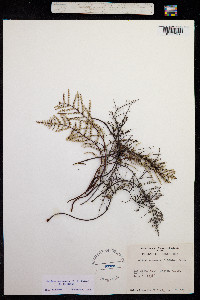Pellaea mucronata
|
|
|
|
Family: Pteridaceae
Bird-Foot Cliffbrake
[Pellaea macronata (D.C. Eaton) D.C. Eaton] |
Stems compact, ascending, stout, 5--10 mm diam.; scales bicolored, linear-subulate, 0.1--0.3 mm wide, centers black, thick, margins brown, thin, erose-dentate. Leaves monomorphic, clustered on stem, 7--45 cm; croziers sparsely villous. Petiole dark brown, lustrous, flattened to slightly grooved adaxially, without prominent articulation lines. Blade ovate-deltate, (2--)3-pinnate proximally, 4--18 cm wide; rachis brown throughout, straight, shallowly grooved adaxially, usually glabrous. Pinnae perpendicular to rachis to strongly ascending, not decurrent on rachis, usually with 9--40 ultimate segments; costae straight, 10--70 mm, much longer than ultimate segments. Ultimate segments narrowly oblong, 2--12 mm, leathery, glabrous; margins recurved to strongly revolute on fertile segments, usually covering more than 1/2 abaxial surface, borders greenish, usually dentate; apex mucronate. Veins of ultimate segments obscure. Sporangia short-stalked, containing 64 spores, intermixed with abundant farina-producing glands. Pellaea mucronata encompasses two morphologic extremes that tend to occupy different habitats and are treated here as subspecies. The typical 3-pinnate form ( P . mucronata subsp. mucronata ) is scattered throughout California and southern Nevada, usually below 1800 m elevation. The 2-pinnate form with ascending, overlapping pinnae ( P . mucronata subsp. californica ) is apparently confined to the Sierra Nevada and Transverse Ranges of California at elevations greater than 1800 m. The taxonomic status of these entities remains in dispute, and they are often treated as mere ecological forms. W. H. Wagner Jr. et al. (1983) indicated that natural hybrids formed between P . bridgesii and these two taxa are morphologically distinct, suggesting that the differences observed between the subspecies of P . mucronata are genetically based. In addition to P . bridgesii , subsp. mucronata apparently hybridizes with both P . truncata and P . brachyptera (see comments under those species).
Wiggins 1964, FNA 1993 Common Name: birdfoot cliffbrake Rarity: None General: Small, rigid dry ferns of rocky places with nodose-multicipital rhizomes that are densely clothed with attenuate-subulate, bicolored scales that are 2.5-4 mm long, the scale centers are black and thick, with brown margins that are thin. Leaves: Monomorphic, clustered on stem, 7-50 cm, the blade ovate to deltate, with 2 or 3 pinnate proximally, these 4-18 mm wide, the rachis is brown and straight with shallow groves on the adaxial side, usually the stems are glabrous. The pinnae are perpendicular to the rachis to strongly ascending, with 9-40 ultimate segments, these 10-70 mm, leathery, glabrous, margins recurved to strongly revolute on fertile segments, with dentate borders and a mucronate apex. Sporangia: Short stalked, with 64 spores. Ecology: Found often in rocky habitats, between and among boulders and under rocks, on a variety of acidic to mildly basic substrates from sea level to 10,000 feet (0-3048 m), sporulates late spring-summer. Notes: FNA treats two subspecies: subsp. mucronata and subsp. californica but they remain disputed taxonomically. FNA does not list the presence of this species in Arizona. Ethnobotany: Plant was used medicinally for hemorrhage, for skin sores, as blood medicine, used to make a tea. Etymology: Pellaea is from the Greek pellaios, dark, alluding to the stalk, while mucronata refers to the mucro tipped leaf. Synonyms: Allosorus mucronatus, Pellaea ornithopus Editor: SBuckley 2014 |

























































































